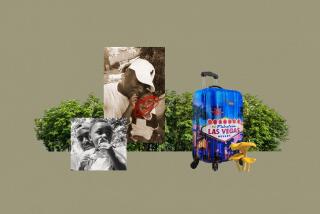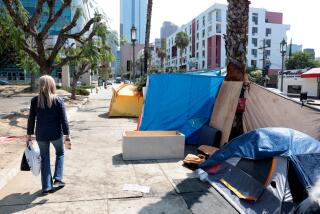Mom Resolves to Save a Son From Himself
LAS VEGAS â Mary Lou Gordon wasnât able to save her four marriages. Or her first son. But this son would be different. There was hope for Keith.
He was handsome, artistic, a natural at landscape design. He liked animals, cooked meals for his mother and tried hard to be a good son.
Mary Lou, now 71, tried hard to be a good mother, always bailing him out of trouble and trying to get him off drugs.
When he was a boy, his blond hair and eager grin always attracted attention.
âHe was adorable. He was so beautiful. Iâd go to the market and the clerk would say: âHeâs too pretty to be a boy.â â
That was long ago. In recent years, he was a shell of the man he used to be. His teeth were rotting and his good looks had faded. He was dirty, used up at age 39. Drugs made him say things that he didnât mean and turned him into a thief and a liar.
Mary Lou lived in fear, never knowing what her son would do.
But she knew what she would do.
She would save him.
*
Mary Lou always chose the wrong husbands. They would drink, just as her father had, and they were often violent.
She had married her first husband to get out of the house where she grew up in North Hollywood. She didnât love him, but they had gone to junior high together and she thought that he was nice enough.
In 1952, their blue-eyed, brown-haired son was born, John Carl Burns Jr.
The marriage ended and Mary Lou met husband No. 2. It was the same story -- drinking and arguing -- and the couple came to Las Vegas in 1960 to get a quickie divorce.
Mary Lou stayed and bought a small house.
She got a job as a hostess at the old Hacienda hotel-casino and soon fell in love with a pit boss. They married and, nine months later in 1963, Keith Fletchall Jr. was born. His father left three months later.
For a time, it was just the three of them. She worked two jobs, as a secretary and at a golf course, so she could put Keith in a private preschool and John in braces. She joined the Mormon church, taught Sunday school and was a Cub Scout den mother. The boys struggled in school, so she got them tutors.
She tried marriage No. 4, but it ended after five years.
Keith won perfect-attendance awards and sports honors, and was president of the weightlifting club. Friends nicknamed him â007â because he was handsome and liked to imitate James Bond. He spent his free time working on his faded olive green 1967 Mustang.
Lora Susca, his high school girlfriend, remembers his charm. âHe could schmooze his way into anything.â
âKeith was so animated when you met him,â said family friend Julie Gialketsis, who attended junior high and part of high school with Keith. âAnd his brother was like a better-looking Dennis Quaid.â
Mary Louâs marriages hadnât worked, but her sons were a different story. She could do this, rear them on her own. Get a good education and youâll have a nice job, she told them.
But something happened to John.
When he returned from a three-year stint in the Navy after high school, he was drinking a quart of vodka a day and had turned to drugs. Mary Lou wrote him a letter when he checked himself into a rehabilitation center.
âYou come from a long line of alcoholics,â she wrote, remembering her fatherâs and grandfatherâs troubles. âItâs the road to destruction. Itâs in your genes and youâre going to have to really fight it.â
In 1985, John overdosed on morphine. He was 32. His younger brother was a pallbearer at the military funeral.
Mary Lou blamed herself, just as she had for the failure of her marriages.
She told Keith then: âBe careful. Look what can happen to you.â
Keith drank and took drugs in high school. But he was just experimenting. Wasnât he?
His mother told herself that life would be better. Keith was different. He was the son she spoiled rotten and doted on, always giving him everything he wanted. Cars, trucks, stereos.
When his brother died, Keith was already running with a fast crowd in Beverly Hills, where he had moved after graduating from high school in 1981. He worked various jobs -- landscaping, construction, security -- and told his mother that he and his friends would drink, do cocaine and carouse into the early morning.
With Keith gone, Mary Lou decided that she needed a gun. There might be a break-in and she wanted to be prepared. She took a shooting course at the North Las Vegas Police Department and bought a .25-caliber pistol.
Then she got a phone call from Keith. Could he come home? He needed to dry out.
Mary Lou, knowing that she could save him, of course said yes.
But Keith soon was using cocaine, marijuana, methamphetamine. His new friends were drug dealers and users.
It was happening again. Another son. Another life slipping away.
He couldnât hold a job and had a string of driving problems -- citations and wrecks. His mother made his car payments, paid his fines and hired an attorney to get drug possession charges dropped.
She wrote him a letter, like the one she had written her first son. Please get help, she told him.
Years passed and Keith slipped further into addiction. Mornings were the worst, when he was having withdrawals. He would scream, throw things and beg for money. Once he took a crowbar to his motherâs car.
Still sheâd say that wasnât Keith; it was a monster the drugs had created.
Mary Lou read books on codependent children and drug addicts. She went to Al-Anon and Tough Love meetings. She learned that she was an enabler. She was letting Keith treat her badly.
Finally, she got a restraining order against him and had him arrested.
But when he was released, how could she turn her son away?
âHeâd come back and say, âIâm hungry,â and Iâd let him in.â
Thatâs the cycle of codependency. It allows both people to act in sick ways, says Dr. Lawson Bernstein, a Pittsburgh neuropsychiatrist and expert in addiction medicine.
âIt allows the addict to forgo responsibility for his or her actions, and it allows the other person to exert some degree of control over the individual,â he said.
âThe only way youâre ever going to save an addict is to not save them.â
Friends who had seen Mary Lou with a black eye and a bad ankle told her: Stop helping Keith; kick him out. Those were accidents, she said; her friends knew better.
âI feel like that sheâd just been in hell for the last 20 years
Another friend, Joe Beth Cassell, said: âHow far do you go to get involved in other peopleâs business?â She wanted to report Keith for abuse, but Mary Lou refused.
âI have my own guilt behind this,â Cassell said.
Keith kept trying rehabilitation programs -- acupuncture, counseling, yoga, exercise -- and his mother kept hoping.
But things got worse. Keith became paranoid. He was convinced that Mary Lou was putting scorpions in his clothes and microphones in the doorknobs. He ripped the doorknobs off and cut up the clothes with scissors.
He sold his motherâs clothes, shoes, furniture and television for drugs. He even traded toilet paper.
Mary Lou often spent nights with friends or sat in her car for hours, afraid to go into her home.
âGod, just make him well,â she said she prayed.
âHeâd cry and say, âI donât want to be a drug addict because I know Iâm going to burn in hell for what Iâve done to you,ââ she said.
There was a good side to Keith. He called the Humane Society when he thought that a neighborâs dog was being mistreated. He cooked dinners for his mother.
He told her that he wanted to try another program. Mary Lou took him three times to enroll in a Salvation Army drug center, but he never returned for an evaluation.
On May 31, after Keith pawned the title to his truck for drug money, he told his mother that he needed $75 to get it back.
âHe said, âItâs over. This is it.â So I wrote a $75 check,â she recalled.
The money went for drugs. And the next morning, June 1, he wanted more.
No, Mary Lou said. She was standing her ground. This time she meant it. She had no more money. She had written the check against her Social Security money that wasnât even in the bank yet.
Furious, Keith started breaking furniture, throwing things and cursing.
She had never seen her son like this. She knew that she needed to get away from him.
Keith was holding a baseball bat, chasing her down the hall with it.
She went into her bedroom. Her son followed with the bat.
âI knew when he came at me with a bat, that was it,â she said, sobbing as she recalls the scene. âI really knew he was out of his mind and going to kill me.â
The overnight case on her bed contained the gun that she had bought years ago. She always kept it loaded.
He started to come toward her with the bat.
She reached in, pulled out the pistol and lifted it.
She fired.
Once. Twice.
Keith fell to the floor at the foot of her bed, shot in the head and shoulder.
Mary Louâs knees buckled and she fell.
It was so fast, a blur. What had she done?
âI heard him gasp. I had to step over his body to call 911.â
Her friends were stunned but not completely surprised. As Cassell said, âI thought he would kill her.â
Sitting in the house she used to share with her son, Mary Lou repeated that she had tried, and added: âHe really did love me. I always hoped against hope.â
Police and prosecutors determined that it was justifiable homicide. Mary Lou was saving herself.
She is still trying to sort out how she sees it.
Keith was the one she was supposed to save.


